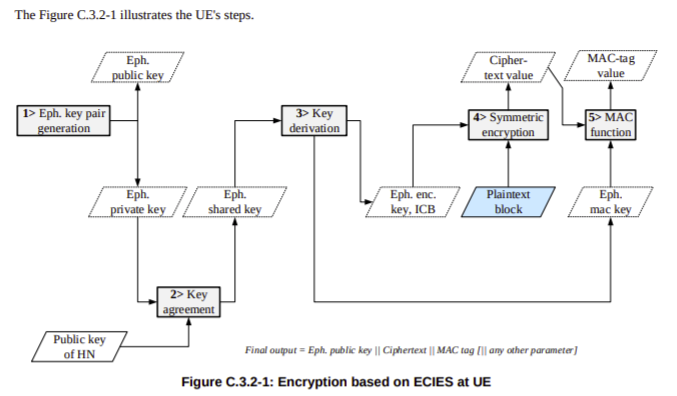The SUPI (Subscription Permanent Identifier) replaces the IMSI as the unique identifier for each Subscriber in 5G.
One of the issues with using IMSI in LTE/EUTRAN is there were a few occasions where the IMSI was sent over the clear – meaning the IMSIs of subscribers nearby could be revealed to anyone listening.
So what is a SUPI and what does it look like? Well, most likely it’ll look like an IMSI – 15 or 16 digits long, with the MCC/MNC as the prefix.
If you’re using a non-3GPP RAT it could be a RFC 4282 Network Access Identifier, but if it’s on a SIM card or in a Mobile Device, it’s probably exactly the same as the IMSI.
SUCI Subscription Concealed Identifier
Our SUPI is never sent over the air in the clear / plaintext, instead we rely on the SUCI (Subscription Concealed Identifier) for this, which replaces the GUTI/TMSI/IMSI for all plaintext transactions over the air.
Either the UE or the SIM generate the SUCI (if it’s done by the SIM it’s much slower), based on a set of parameters defined on the SIM.
The SUCI has to be generated by the UE or SIM in a way the Network can identify the SUPI behind the SUCI, but no one else can.
In LTE/EUTRAN this was done by the network randomly assigning a value (T-MSI / GUTI) and the network keeping track of which randomly assigned value mapped to which user, but initial attach and certain handovers revealed the real IMSI in the clear, so for 5G this isn’t an option.
So let’s take a look at how SUCI is calculated in a way that only the network can reveal the SUPI belonging to a SUCI.
The Crypto behind SUCI Calculation
As we’ll see further down, SUCI is actually made up of several values concatenated together. The most complicated of these values is the Protection Scheme Output, the cryptographically generated part of the SUCI that can be used to determine the SUPI by the network.
Currently 3GPP defines 3 “Protection Scheme Profiles” for calculating the SUCI.
Protection Scheme Identifier 1 – null-scheme
Does nothing. Doesn’t conceal the SUPI at all. If this scheme is used then the Protection Scheme Output is going to just be the SUPI, for anyone to sniff off the air.
Protection Scheme Identifier 2 & 3 – ECIES scheme profile A & B
The other two Protection Scheme Identifiers both rely on Elliptic Curve Integrated Encryption Scheme (ECIES) for generation.
This is better known as Elliptic Curve Encryption Scheme, it’s primarily used for Cryptography. Crypto is crazy complex, and I’m a mere mathematical mortal, but there’s a great post on the Cloudflare blog on the topic that touches on Elliptic Curve Encryption.
So if both Profile A & Profile B rely on Elliptic Curve Integrated Encryption Scheme, then what’s the difference between the two?
Well dear reader, the answer is semantics! There’s lots of parameters and variables that go into generating a resulting value from a cryptographic function, and Profile A & Profile B are just different parameters being used to generate the results.
For crypto nerds you can find the specifics in C.3.4.1 Profile A and C.3.4.1 Profile B outlined in 3GPP TS 33.501.
For non crypto nerds we just need to know this;
When the SIM is generating the SUCI the UE just asks for an identity by executing the GET IDENTITY command ADF against the SIM and uses the response as the SUCI.
When the UE is generating the SUCI, the UE gets the SUCI_Calc_Info EF contents from the SIM and extracts the Home Network Public Key from it’s reply. It uses this Home Network Public Key and a freshly created ephemeral public/private key pair to generate a SUCI value to use.
Creating the SUCI
After generating a Protection Scheme Output, we’ll need to add some extra info into it to make it useful.
The first digit of the SUCI is the SUPI type, a value of 0 denotes the value contained in the Protection Scheme Output is an IMSI, while 1 is used for Network Access Indicator for Non 3GPP access.
Next up we have the Home Network Identifier, which in a mobile environment is our PLMN (MCC/MCC).
Then a Routing Indicator, 1-4 digits long, is used with the Home Network Identifier to route the Authentication traffic to the UDM that contains that subscriber’s information, ie you may have MVNOs with their own UDM. If the routing indicator of 10 is assigned to the MVNOs SIMs then the AMF can be set to route traffic with a routing indicator of 10 to the UDM of the VMNO.
The Protection Scheme we covered earlier, with the 3 types of protection scheme (Null & two relying on Elliptic Curve Integrated Encryption Scheme).
Home Network Public Key Identifier identifies which Public Key was used to generate the Protection Scheme Output.
Finally we have the Protection Scheme Output which we covered generating in the previous session.
Usage in Signaling
The SUPI is actually rarely used beyond the initial attach to the network.
After authenticating to the network using AKA and the SUCI, in 5GC, like in LTE/EUTRAN, a shorter GUTI is used which further protects the subscriber’s identity and changes frequently.

Thanks a lot for the explanation, i was looking for info on RI significance wrt to udm and this was really useful.
Hi,
Regarding the home network public key is provisioned to the SIM.
How and When is this performed?
During the personalization process
My UDM is not program for SUCI at this time, but i want to create SIM and activate the SUCI to anticipate the future, but it will work ?
You’d be better to set the SUCI concealment algorithm on the SIM to NULL for now and OTA update the SIMs down the line.